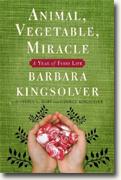Animal, Vegetable, Miracle
Barbara Kingsolver, Camille Kingsolver and Steven L. Hopp
book reviews:
· general fiction
· chick lit/romance
· sci-fi/fantasy
· graphic novels
· nonfiction
· audio books
· author interviews
· children's books @
curledupkids.com
· DVD reviews @
curledupdvd.com
newsletter
win books
buy online
links
home
for authors
& publishers
for reviewers

 |
Animal, Vegetable, Miracle: A Year of Food Life Barbara Kingsolver, Camille Kingsolver and Steven L. Hopp HarperCollins Hardcover 384 pages May 2007 |
|
A third of the world’s fossil fuel habit goes to supporting agriculture. Though that’s not the reason for the rise in organically grown food, it’s a good one. (The main reason is concern for the health of body, soul and soil.) A third of the world’s oil goes to growing and trucking food around the planet—and, in the U.S. at least, food transportation is tax deductible.
Barbara Kingsolver, the noted novelist, and her family broke the habit. They did a geographical, moving from water-hog Tucson to a small farm in the Shenandoah Valley. There they got off the food grid and determined that they’d try to live for a year on only what they could grow or obtain within a certain, limited radius. They weren’t self-sufficient, by any means. To the contrary, one of Kingsolver’s driving themes is eating locally and doing business directly with local agriculturists. To this end, the Kingsolver-Hopp crew bust ass in a three-acre garden (and just where is the line between garden and farm? is a question she muses on), grow squash until they think their heads are going to explode, not to mention a zillion other kinds of vegetables. Growing it is one thing; processing the fruits of the earth into food that’ll last over winter is another. It takes a bit of labor to can a few hundred pounds of tomatoes, but that and a barrel of pasta made from locally grown wheat will get you through the long night of the year and beyond. It’s not a vegetarian or any other particular diet this family effort of a book preaches. (Hopp, Kingsolver’s husband, contributes scientific and ideological vignettes with copious Web links, while daughter Camille Kingsolver serves up recipes (how many ways can you serve ready-steady foodstuffs, like canned tomatoes?) with a dash of what’s-it-like-growing-up-with-a-foodie? thrown in. The youngest daughter, Lilly, raises chickens for eggs and meat, while Kingsolver raises turkey for Thanksgiving and a winter supply of protein. Rather, the family brings a passion born of rational intelligence to a subject far too often freighted with emotions, myths and outright lies. Although Kingsolver uses the neologism “localvore” (by etymological rights, I’d guess “locivore” would be better) and CSA (community-supported agriculture), what the book ultimately dwells on, in its choice and deployment of words and generosity of intelligence, is eating smart and caring about the way your food gets to and through you. As she points out, “Organic farming involves a level of biotic observation more commonly associated with scientists than with farmers”—meaning, instead of identifying bugs and encouraging certain of them, the petro-farmer sprays them all dead. Or tries, at least. Kingsolver is a cunning and funny wordsmith, as when she writes: “Like many other modern U.S. cities, [Tucson] might as well be a space station where human sustenance is concerned. Virtually every unit of food consumed there moves into town in a refrigerated module from somewhere far away. Every ounce of the city’s drinking, washing, and goldfish-bowl-filling water is pumped from a nonrenewable source—a fossil aquifer that is dropping so fast, sometimes the ground crumbles.”Industrial food, as foodies call petro-agriculture, is “consumed” in “units” transported in “modules.” And her choice of the amazing but familiar fact (especially out West), ground crumbling as water table falls, is a knowing nod to the headlines of our own lives. Kingsolver and her brood capture the absurdity of our current situation and then proceed, in a year of DIY food, to show how it might be different. Animal, Vegetable, Miracle Originally published on Curled Up With A Good Book at www.curledup.com. © Brian Charles Clark, 2007 |
|
|
|
 Click here to learn more about this month's sponsor! |
|
| fiction · sf/f · comic books · nonfiction · audio newsletter · free book contest · buy books online review index · links · · authors & publishers reviewers |
|
| site by ELBO Computing Resources, Inc. | |
 No wonder the industrial food chain is so addictive. Not only can we get what we want when we want it (apples in late winter and spring from New Zealand, to give just one example), but we can get it cheap, too.
No wonder the industrial food chain is so addictive. Not only can we get what we want when we want it (apples in late winter and spring from New Zealand, to give just one example), but we can get it cheap, too.